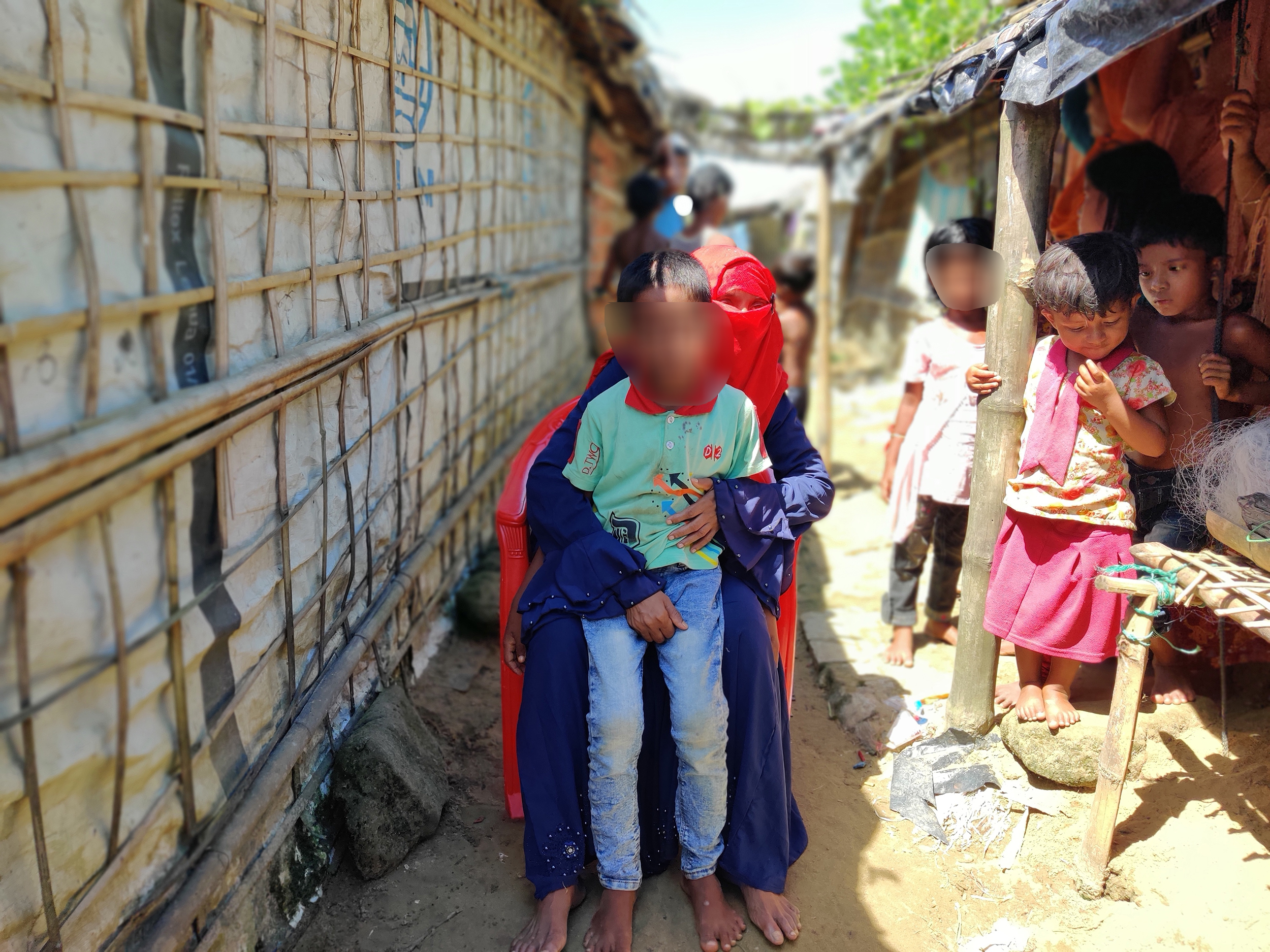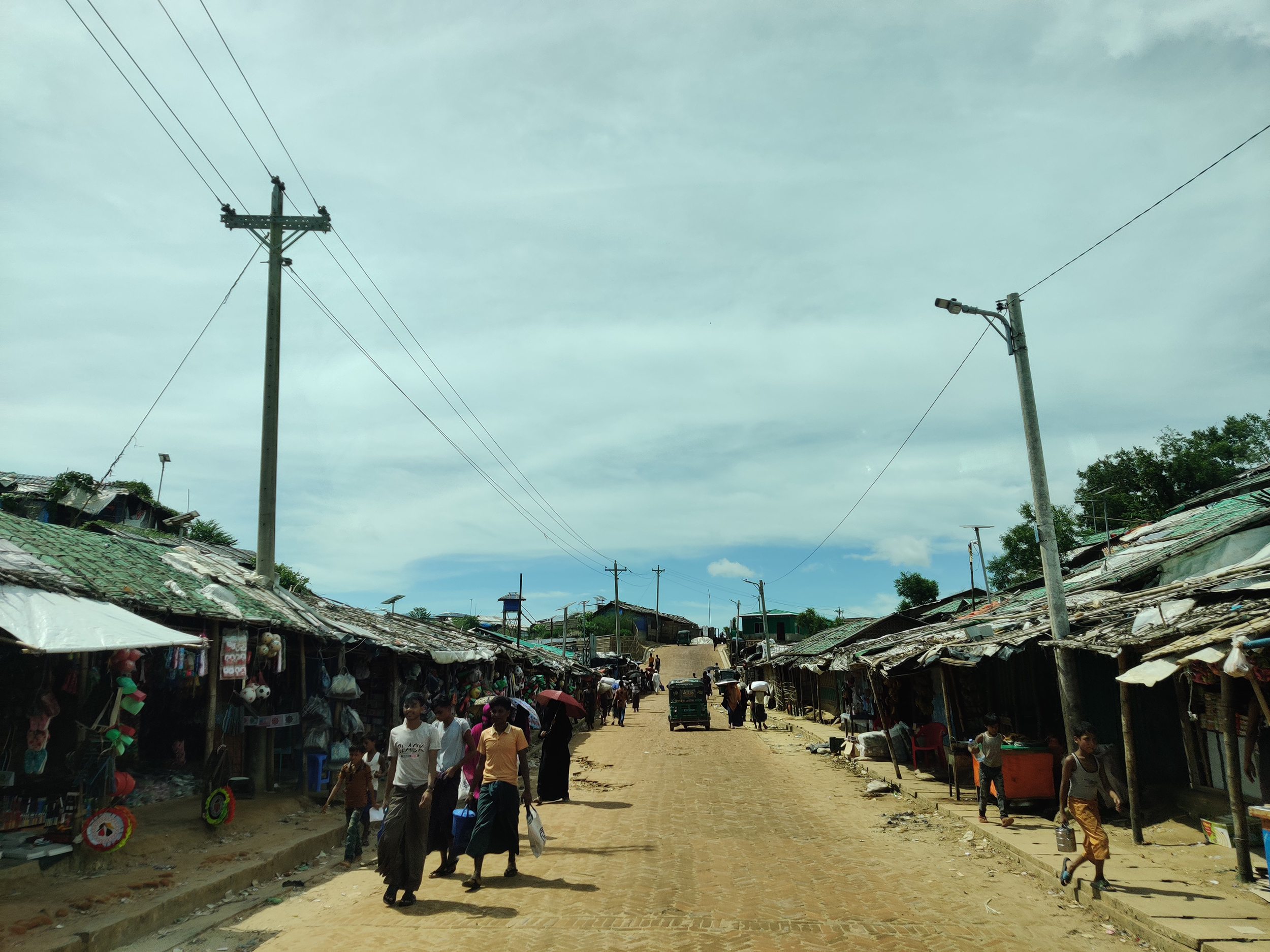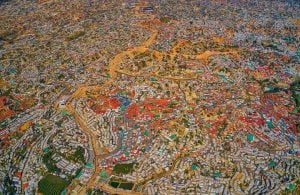This article was originally published on The Third Pole under a Creative Commons licence.
![In the southeastern corner of Bangladesh, boats lined up at the Holbonia fishing harbour, notorious as the starting point of illegal voyages to Malaysia by trafficked Rohingya refugees [Image by: Nazmun Naher Shishir]](https://www.thethirdpole.net/content/uploads/2021/01/fishing_boats_in_line_at_Holbonia_trafficking_Port._Teknaf.Photo_NNS.jpg)
Rubina returns from the market in the Rohingya refugee camp near Teknaf in southeast Bangladesh and flops down on the floor of her small shack. “I hope I can reunite with my husband someday,” the 38-year-old says in a tired voice.
She has tried. Her husband Roshidullah left their original home in Myanmar’s Rakhine state some years ago to work illegally in Malaysia. In 2017, Rubina and her son fled a violent military crackdown in Myanmar and moved to Bangladesh along with around a million Rohingya refugees.
Roshidullah then paid human traffickers so that Rubina and their seven-year-old son Enamullah could join him. “I did not know where I was going,” Rubina tells The Third Pole. “My husband told me that the Bengali agent is a trusted man and had prepared all the paperwork so that my son and I can reach him in Malaysia. I do not know how much he had to pay.”
They were two of the 396 survivors among the refugees who set sail in a fishing trawler to Malaysia from Rohingya camps in southeastern Bangladesh in mid-February 2020. Newly alert to the Covid-19 pandemic, Malaysian authorities blocked the trawler at sea, and the would-be illegal immigrants spent 55 days adrift, not allowed to land anywhere.
Thirty of them died before Bangladesh sent a vessel to bring back the rest. They were so starved and dehydrated when they disembarked that “most just flopped down on the beach like dying fish,” said an observer.
Would she have gone if she had known the risks? “I would never risk my son’s life.” It’s not a straight answer, but it’s the only one she gives.
On her return to the refugee camp near Teknaf in Cox’s Bazar district of Bangladesh, Rubina lost touch with her husband. She has not heard from him since April 2020.
Rubina is one of thousands of Rohingya who have attempted to make the dangerous journey across the Bay of Bengal to Malaysia, lured by a sophisticated and ever evolving international network of human traffickers profiting from the misery of others. From March 2019 to March 2020 alone there were 15,000 recorded trafficking incidents – with actual numbers likely to be much higher. The humanitarian crisis peaks in the winter when the sea is calmer. But many people still lose their lives.

Marriage and the Malaysian dream
Outside their shack in the same refugee camp, sisters Banu, 21, and Nurun, 22, are drying their hair in the mellow winter sunshine. They know how lucky they are to be alive.
Their maternal uncle – an illegal immigrant in Malaysia – paid traffickers to get the sisters over. The idea was to get them married and settled in a new life, a new country.
On a day in February, Banu and Nurun crammed into a small boat at Holbonia, a fishing harbour notorious for being used by human traffickers. Their destination – like that of other trafficked Rohingya refugees – was Saint Martin’s island off the Bangladesh coast. That is where the traffickers move their passengers into larger vessels.
“Inevitable are the decrees of God,” says Nurun. “Our boat sank on the way to Saint Martin, west of the island. There were 137 of us in the boat. Only 72 were rescued alive.”
“Uncle had said the journey would be tough,” Banu pipes up. “We just had to hold on to our faith. But we have seen death in front of our eyes. We will live here till death and never attempt to go anywhere illegally.”
Their dream collapsed. Banu and Nurun do household chores, gossip with friends and try not to think of the future.
Trafficking in thousands
The UN’s International Organisation for Migration (IOM) has said that human trafficking is on the rise from the sprawling refugee camps in south-eastern Bangladesh. The government reported over 4,400 trafficking cases remained pending investigation or prosecution as of December 2019. Around 15% involved children. Interpol’s rule of thumb is that for every case identified, 10 slip through.
According to The UN High Commissioner of Refugees (UNHCR), since January 2020 over 2,300 Rohingya – many of them women and children – have embarked on journeys across the Bay of Bengal seeking work, reunification with family members or to get married. The majority have left from camps near Cox’s Bazar.
UNHCR reports that the refugee camps in Bangladesh are now home to over 723,000 Rohingyas who fled genocide in Myanmar in August 2017.
Since August 2017, human trafficking from these camps has been a constant issue. The Bangladesh government hopes its recent decision to move a large number of refugees to an offshore island – Bhashan Char – will stem that tide. But observers do not think it will make much difference.
If we are successful it takes only seven to eight days to reach Malaysia by sea. It is not much of a hazard if it brings a fortune.
Bablu, a traffickers’ agent
The move away from the refugee camps started with people trickling through to the big cities of Bangladesh – especially Dhaka and Chattogram. Trafficking to Malaysia followed.
Bablu, 35, is a traffickers’ agent. “People want to live a better life,” he tells The Third Pole. “These Rohingyas have no life inside these unhealthy camps. I help them to live their dreams, to go to their relatives abroad. If we are successful it takes only seven to eight days to reach Malaysia by sea. It is not much of a hazard if it brings a fortune.”
Fortune is a relative term. It comes at a steep price, if it comes at all. Many Rohingyas use their last bits of money and jewellery to pay for the voyage. And this after their relatives in Malaysia have paid the bulk.
“We take anything between 30,000 and 300,000 [Bangladeshi] taka (USD 355-3,545) per refugee,” Rahamat, another traffickers’ agent, tells The Third Pole. “Often their relatives from Malaysia contact us and send the money directly. Most women are not aware of the process. They just trust their relatives and us.”
The agents go around the camps identifying people whose relatives are in Malaysia, Rahamat explains. Then they offer promises of a better life. Rahamat says Rohingyas, Bangladeshis and boatmen are all involved in trafficking.
1,000 BDT = approx. 12 US dollars
Rahman, a local journalist who has been reporting on the trafficking, says, “The refugees leave in small boats from 30-35 places – including Holbonia, Sabrang, Kutubdia, Katabania, Hariakhali and Inani in Teknaf; Badamtoli in Ukhia; Sitakunda and Majhirghat near Chattogram. Then they are transferred to large vessels near Saint Martin’s Island. These trafficking syndicates span across Bangladesh, Myanmar, Thailand and Malaysia.”
The murderous voyage
Many cannot pay for the voyage in full despite their best efforts, especially since traffickers have a habit of making new demands once the vessel has sailed from St Martin’s Island. Those who cannot meet these demands are reportedly disembarked at Takua Pa in southern Thailand instead of being taken to Malaysia.
There the would-be immigrants are reportedly held to ransom. Tales of torture, rape and murder are common.
Those who manage to satisfy the traffickers are placed in small boats off Langkawi – Malaysia’s famous resort island.
The fortune in Malaysia
Noorul is a Rohingya who smuggled himself into Malaysia when his family was still in Myanmar. “We do not get paid enough here because we are undocumented,” he says over the phone. “Our [forged] passports were confiscated. Many of my Muslim brothers have become sick due to overwork. We live a miserable life here. I had a proper job before the Coronavirus pandemic. Now I have only part-time jobs.”
“Still, it is better than in the Rohingya camps in Bangladesh. My family lives in your country [a camp near Cox’s Bazar] and I send them money now and then. If I had enough money, I would ask them to come to Malaysia by boat. Everyone comes here like this because this is the only way for us.”
Illegal at every step
It is illegal to leave the Rohingya refugee camps in Bangladesh, though many go out to work every day. There are no jobs in the camps, nor any other way to make a living. Living cheek by jowl, with few schools and no college, the camps are full of young people desperate to get out.
It is fertile ground for traffickers. The refugees are told they will be taken to India, Thailand or Malaysia. Once outside the camp, they are made to do forced labour instead. There have been reports of women being forced into prostitution. And all know they cannot go to the authorities because they have taken the first illegal step by leaving their camp.
Tougher action needed
The authorities are not doing enough to tackle the problem. In its 2020 Trafficking in Persons Report: Bangladesh, the US Department of State wrote, “The [Bangladesh] government did not establish clear legal reporting mechanisms within the camps, which impeded Rohingyas’ access to justice and increased impunity for offenders. […] The Bangladeshi High Court did not entertain anti-trafficking cases filed by Rohingya, despite the law allowing Rohingya to file trafficking cases in Bangladeshi courts.”

The official response
“We have increased our monitoring so that Rohingyas remain inside the camps,” Lieutenant Shah Zia, staff officer at the Bangladesh Coast Guard, told The Third Pole. “Regardless of the season we are on duty 24/7 to prevent trafficking. The measures we have taken include strict sea-route monitoring.”
Milin, who has a semi-official post as member of a Rohingya development committee in the camp near Teknaf, says, “We know that it [trafficking] happens every now and then. We are not as worried about Coronavirus as of trafficking of our men and women. Winter is the time most people set sail in search of a fortune on the other shore [Malaysia].”
Asked what he knows about the official response, Rahman – the local journalist – says, “Our law enforcement agencies become proactive only when something goes wrong with the trafficking and people have to be rescued from a trawler. Traffickers are roaming unchecked in the refugee camps, as they are in the rest of the country.”
Laws and armed traffickers
Attempts to rein in the traffickers have led to violence. In March 2020, Bangladeshi security officials killed seven suspected members of a Rohingya gang allegedly involved in human trafficking around a refugee camp near Teknaf. The same day, another suspected trafficker was killed in a gunfight with security forces in Cox’s Bazar, and 35 refugees were detained as they were allegedly planning to leave for Malaysia.
A month before that, security forces arrested three alleged members of a human trafficking racket while rescuing three Rohingyas, including a girl from Comilla district. Nineteen alleged traffickers were chargesheeted the same month.
There has been a spurt of such cases reported in the media since 2019. On May 15 that year, a group of traffickers opened fire on policemen near a camp in the Teknaf area. Two alleged traffickers were killed in the subsequent gunfight.
Bangladesh has the 2012 Prevention and Suppression of Human Trafficking Act and the National Action Plan 2018-22 to combat human trafficking. In 2018, it trained 23,890 police officers on how to combat trafficking. Last February, it decided to set up seven special courts for human trafficking cases.
Rahman says these efforts have not really succeeded “because it is always the little fish that get caught”. To succeed, the pushback to traffickers has to come from the refugees, he feels.
Louise Donovan, communication officer of UNHCR, told The Third Pole, “UNHCR and humanitarian partners are regularly reaching out to refugees on issues of trafficking and exploitation, sensitising them on risks and helping the community protect itself. Providing information to the community is key in raising awareness about the issue, and to help mitigate the risks.”
Old dream
The Rohingya dream of a better life in Malaysia predates the 2017 violence and the flight of a million Rohingyas to Bangladesh. Between 2012 and 2015, an estimated 125,000 people were trafficked from Bangladesh, most of them Rohingya.
During this period, a mass grave was found in a forest on the Thailand-Malaysia border near Takua Pa, giving credence to the tales of kidnapping, torture, rape, murder. Trafficking went down after 2015 but restarted in August 2017, at the height of the human flood from Myanmar.
Using data gathered by the Bangladesh Rural Advancement Committee (BRAC) and the police, a Bangladesh media report compiled trafficking-related tragedies. From August 2017 to February 2018, 197 bodies were recovered from the sea, 28 boats sunk and at least 500 people left missing.
Bangladesh security forces estimate that around 1,600 Rohingyas were trafficked in the one year starting March 2018. Their records show 15 trafficking-related deaths during this period.
The records show a big spurt after that – around 15,000 Rohingya trafficked from March 2019 to March 2020, most of them women and children.
Recurring dream
Sabikunnisa, 34, has set sail three times for Malaysia, but has failed to reach shore to join her husband Amanullah, an undocumented labourer.
Sabikunnisa now shares a one-room shack in the refugee camp near Teknaf with her brother, his wife and their five children. Sitting at the doorway of the shack, she says, “Now I do not have any money left to spend. My husband has no work in Malaysia, he is ill now.”
“But if I get any chance to arrange some money, I will try again. I have learned my lesson from the last trip, when we were adrift for almost two months. I’m aware of the risk of human trafficking. But I also see other people reaching Malaysia successfully. I only wish to see my husband someday.”

Names of all non-official interviewees have been changed to protect them from traffickers.






